Uz se tesim

wet plate collodion - mokrý kolodiový proces
#101

Publikováno 3 May 2009 - 08:42:45
Uz se tesim
#102

Publikováno 3 May 2009 - 11:26:28
#103

Publikováno 3 May 2009 - 11:46:18
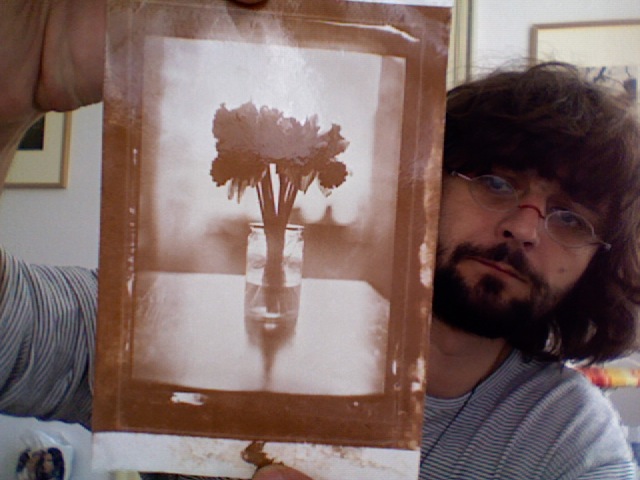
cekam cekam na obrazky
tady je muj prvni, jeste mokrej, slanej pozitiv. pouzil jsem na nej tri tydny pouzivanej dusičnan stribrnej z kolodiovyho dipperu a celkem maka pekne.
#104

Publikováno 3 May 2009 - 12:02:41
me slanaky vychazeji do cerna,
jinak tady je ten ambrotype
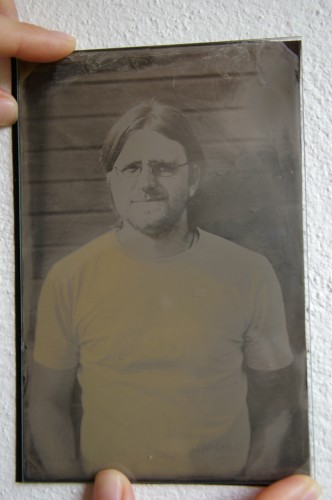
na setkani muzu vzit nejake vanDajky, slanaky a ted naposled jsem zkousel albumin[/img]
#105

Publikováno 3 May 2009 - 12:17:37
Tak už se to pěkně rozjíždí.
Jestli bude místo v pracovní skupině, tak bych se hlásil.
Už jsem to probíral ze Zdeňkem. Mám dům v Čelákovicích, před demolicí.....ideální místo na pokusy
Ovšem, vzhledem k tomu, že je před demolicí...tomu odpovídá i vybavení
#106

Publikováno 3 May 2009 - 12:24:34
gratulace velika.
#107

Publikováno 3 May 2009 - 12:31:48
ten muj slanej neni slanej je to ALBUMIN z chloridu amonneho. jsem to pomotal.
Verni amonniovým solím zůstaneme.
#108

Publikováno 3 May 2009 - 20:36:58
takze hrany skla mam 2x potrene albuminem, kolodium se uz netrha. Do vyvojky jsem pridal trochu lihu, aby se lepe rozlevala po desce. Chemie prefiltrovana (jak zcitlivovaci lazen, tak i vyvojka). Zatim mi to porad dela takove divne mapy, zrejme to bude vyvojkou. A chci skoncit se zcitlivovanim v misce, uz me nebavi donekonecna misku necim prikryvat kvuli svetlu. Dokoncuju dipper. A pripravuju vetsi kazetu 8x10
A pro ty velke desky to chce zcela jiste naredit kolodium etherem a lihem.
#109

Publikováno 3 May 2009 - 20:41:01
#110

Publikováno 4 May 2009 - 01:22:28
#111

Publikováno 4 May 2009 - 07:15:01
100 ml kolodia
50 ml ethanolu
5 ml zasobniho roztoku
#112

Publikováno 5 May 2009 - 21:25:16


#113

Publikováno 5 May 2009 - 21:46:43
#114

Publikováno 6 May 2009 - 06:17:20
#115

Publikováno 6 May 2009 - 07:06:03
a hlavne, hlavne nemam etalon. Nevim, jak ma vypadat kvalitne odvedena prace. Chce to zajet na ten workshop do Budapesti
Ale uz mam slepeny dipper, tak dalsi potencialni problemy vznikajici zcitlivovanim v miskach snad odpadnou.
Uz jsi zkousel neco na hlinik?
#116

Publikováno 6 May 2009 - 08:57:49
Quote
jsi frajer. Moc dobry prace jsi odvedl. A kluci kdy mate cas se stavet pro tu vyhru
Jirka to je skromnost sama
psal jsem ti na email, tak se nejak snad domluvime
#117

Publikováno 6 May 2009 - 09:04:25
Quote
Vasku, ja s tim praveze nejsu vubec spokojeny. Furt to neslape jak by melo
a hlavne, hlavne nemam etalon. Nevim, jak ma vypadat kvalitne odvedena prace. Chce to zajet na ten workshop do Budapesti
Ale uz mam slepeny dipper, tak dalsi potencialni problemy vznikajici zcitlivovanim v miskach snad odpadnou.
Uz jsi zkousel neco na hlinik?
posilam ti tu svoji ferrotypii, tak snad ethalon (nebral bych to vazne) budes mit - akorat je 140let stara, tak pozor
#118

Publikováno 6 May 2009 - 11:40:29
Taky dělam lithprint rok a vůbec se tomu první půlrok nechtělo...
#119

Publikováno 7 May 2009 - 06:23:39
diky Vasek.
#120

Publikováno 7 May 2009 - 06:59:46
Quote
http://www.safina.cz/ - pevná forma (ale hydrát - menší procento H2O) asi za 360Kč/g - cena se měníhosi kde sezenu chlorid zlatity prosim.
diky Vasek.
#121

Publikováno 7 May 2009 - 08:44:33
Quote
jasne Vasku, chce to leta driny a odrikani, nez se dostaneme na urovenchápu, ale je prilis casne aby to makalo superpřesně. Tak za roček to bude vypiplaný.
Taky dělam lithprint rok a vůbec se tomu první půlrok nechtělo...
Johna Coffera
#122

Publikováno 7 May 2009 - 17:33:03
#123

Publikováno 12 May 2009 - 21:12:42
Obdobne mam upravenu uz kazetu pro 10x15cm. Pro ty, kteri se do toho budou chtit poustet - je lepsi upravovat moderni kazety lisco/fidelity, ktere jsou plastove. Ja pro full plate pouzil starou nepotrebnou drevenou 8x10", ma papirovou prepazku, tak uvidim jak se to bude po namoceni chovat.
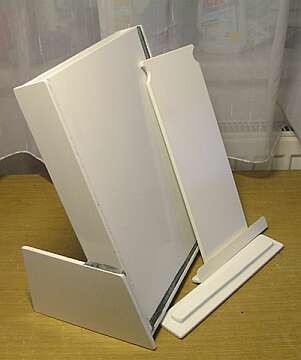
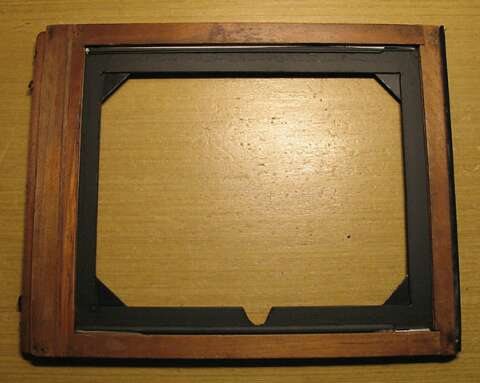
#124

Publikováno 12 May 2009 - 22:53:54
#125

Publikováno 13 May 2009 - 05:56:28
tady jsem taky dokoncil jeden kus z ponekud nepraktickeho ale tradicniho materialu
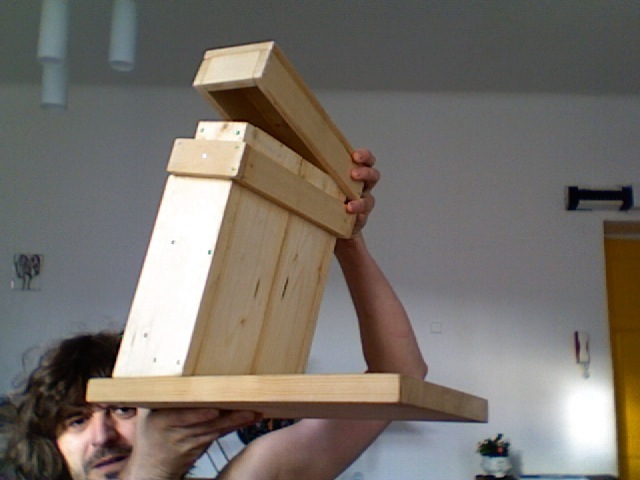
#126

Publikováno 13 May 2009 - 09:32:24
Quote
je to nejaky tvrdy plast. ale ono je to vcelku jedno, vsechno co jde rozumne slepit je pouzitelne. treba plexisklo. pokud to bude ciry material, tak navic jeste musis vyrobit neprusvitny obal kolem. Ja sahnul po tom, co se valelo doma v dilne. Lepeno lepidlem na tvrde plasty, zvenku pak jeste prejete spoje epoxidem.z akeho materialu si vyrabal ten dipper? ak mozes opis aj postup, aby som vedel co ma caka. vdaka
#127

Publikováno 13 May 2009 - 09:39:01
Quote
No skvele uz to jede pratele
tady jsem taky dokoncil jeden kus z ponekud nepraktickeho ale tradicniho materialu
Hezke Vasku, takove prirodni, k tomu procesu se to hodi, jak mas zajistenu stribrotesnost?? mas to vevnitr necim vylite?
#128

Publikováno 13 May 2009 - 21:22:25
#129

Publikováno 13 May 2009 - 22:05:16
tato odpoved je jen domenka a je generovana automaticky.
#130

Publikováno 14 May 2009 - 09:11:53
ja mam octovku ledovou ve skle, pred otevrenim nic citit nebylo. po otevreni
okamzite zmrzla
#131

Publikováno 14 May 2009 - 10:59:18
Mám je na balkoně, tam to nevadí.
#132

Publikováno 14 May 2009 - 10:59:51
#133

Publikováno 14 May 2009 - 12:35:48
tesim se
#134

Publikováno 14 May 2009 - 14:29:50
#135

Publikováno 14 May 2009 - 16:16:25
Quote
v sobotu nebo v nedeli jste hosty.
tesim se
Ahoj Vasku, a kde se nachazi tvuj skromny pribytek??
#136

Publikováno 14 May 2009 - 20:12:08
decka
#138

Publikováno 18 May 2009 - 08:50:03
#139

Publikováno 18 May 2009 - 09:32:19
Quote
Vasku, diky za vcerejsi kolodiovou seanci, kdy byl vzduch prosycen Etherem
I já bych se chtěl přidat k poděkování. Vašku, díky za dokonalý kurz kolodiového procesu.
Vstřebávám zážitky. Ještě se mi klepe ruka, při vzpomínce na polévání desky
Taková šance se naskytne jednou za život.
Díky za rozdělení se tvých vědomostí a zkušeností..... to se jen tak nevidí.
#140

Publikováno 18 May 2009 - 12:40:46
Vasek
#141

Publikováno 18 May 2009 - 15:17:28
#142

Publikováno 18 May 2009 - 15:57:10
Quote
Jak si to tady zpozdenim ctu, mam jednu poznamku k ledove octovce - ucite si to nelijte do plastu, obcas to pak vybuchuje (asi zalezi z ceho je vnitrek flasky a jak dobre dotahnete uzaver). (vim teda jenom o jednom pripadu, ale to mne docela staci)
Ono v tomhle procesu vybuchuje vice veci
#143

Publikováno 18 May 2009 - 16:50:06
Quote
Jak si to tady zpozdenim ctu, mam jednu poznamku k ledove octovce - ucite si to nelijte do plastu, obcas to pak vybuchuje (asi zalezi z ceho je vnitrek flasky a jak dobre dotahnete uzaver). (vim teda jenom o jednom pripadu, ale to mne docela staci)
no celkom si ma vystrasil, hned som si natiahol rukavice, okuliare, kuchynsku zasteru a sup sup ho prelievat do sklenenych flias. a cely cas som cakal kedy mi to vybuchne
#144

Publikováno 18 May 2009 - 16:50:17
Ruce. Decka.
#145

Publikováno 18 May 2009 - 17:06:40
::
DRY COLLODION.
BY P.C. DUCHOCOIS.
EVERY photographer knows how difficult it is to find a collodion suitable for the collodio-albumen, gelatine, or meta-gelatine processes, i. e., a collodion giving a film neither tenacious nor contractible, but very porous, friable, and adherent. Old collodions are recommended as possessing such properties, bat, besides that they are often too much iodised for that purpose, it is to be remarked that, if the collodions prepared with alkaline iodisers answer very well, those iodised with metallic salts (cadmium generally) do not always work as well, for although the collodion becomes coloured, the film keeps for a long time all the characters of the collodion one or two weeks old.
Believing, from observation, that the alkaline and metallic bases reacted on pyroxyline in different manners, desirous to explain that fact, and also to have a formula by which I can surely prepare good collodion for the dry process, I made the following experiment to study the action of alkaline bases in collodion
To a plain collodion giving a thick strong film, very contractible, and easily lifted up in long rays, I added liquid ammonia; immediately it was troubled, and, after a few hours, gave a thinner film, very porous, rotten, and opaque. it took twenty-four hours to clear up, became a fine amber colour, and left a white precipitate of decomposed pyroxyline (cellulose). Caustic potash and caustic baryta in small quantity acted nearly in the same way. Hence, alkaline bases react powerfully on pyroxyline, it is disorganised, and a part is decomposed.
This is very important. It explains--1st. The great fluidity of collodions prepared with alkaline iodisers (particularly when iodide of ammonium is used), and, partly, their instability. 2nd. Why those collodions give a film with less and less body, and the causes of the want of success resulting from it. 3rd. The advantage of alkaline collodion for Taupenot's and Norris's processes, and, generally, for all dry preparations on collodion. It, will be observed that the amount of ammonia added to the plain collodion ought to be proportioned according to the kind of pyroxyline, that is, to the more or less tenacity or contractibility of the collodion, and that ammoniacal collodions cannot support as much iodiser as other ones--4 grains to the ounce is a good proportion for the collodio-gelatine process, and 2 grains are enough for the collodio-albumen.
But since it is easy to prepare a collodion with all the proper qualities for dry preparations, I have adopted a truly dry collodion process (without any kind of preservative' coat) which is very sensitive, and has the advantage of great simplicity. The preparations are--
COLLODION.
Ether concentrated 6 fluid drachms
Alcohol 95% 2 ,,
Pyroxyline 5 grains.
Iodide of ammonium 4 ,,
Liquor ammoniae 3 drops.
SILVER BATH.
Water 1 fluid ounce.
Nitrate of silver 27 grains.
Dilute acetic acid 2 drops.
DEVELOPER.
Gallic acid 1 ounce.
Alcohol 4 ,,
Dilute acetic acid 1 drachm.
Camphor 15 grains.
After sensitising, immerse the plate in water for three or four minutes, and having washed it with distilled water, let it dry in the dark. To develop--first wet the collodion film with water, and then spread upon it a mixture of 1 drachm of the developer, and 3 or 4 ounces of water, afterwards add a small quantity of a solution of nitrate of silver, at 3 per cent, to strengthen the negative. Fix with hyposulphite of soda.
As it has been said, this process is very rapid, and the failures often arise from an excess of exposure; if it is too long, the sky does not blacken, the picture is too equal, and does not take enough intensity in the high lights.
Home ~ Library ~ Science ~ Technology ~ Gallery ~ Video ~ Forum ~ About ~ Search
::
#146

Publikováno 18 May 2009 - 17:17:17
::
Towler, John. The Silver Sunbeam. Joseph H. Ladd, New York: 1864. Electronic edition prepared from facsimile edition of Morgan and Morgan, Inc., Hastings-on-Hudson, New York. Second printing, Feb. 1974. ISBN 871000-005-9
[Previous] Chapter 18 [Next] Chapter 20 Title Page
Table of Contents Search this book Albumen Home
Chapter XIX.
WET COLLODION PROCESS.
IF the collodionized plate, after sensitization in the silver bath, is exposed whilst still moist, the process by which the image is obtained, is called the Wet Collodion process; whereas if the sensitized plates are dried, and used afterward at any indefinite time, the process of the operation is denominated the Dry Collodion process. The Wet Collodion process will form the subject of the following chapters. This process is divisible into two branches, comprehending the methods of preparing collodion positives and collodion negatives.
Collodion Positives--The Melainotype--The Ambrotype.
A collodion positive may be viewed either by reflected light or transmitted light; by reflected light, in the same manner as any picture or engraving is beheld, that is, by looking at it; and by transmitted light, when the picture is seen in or on glass, by looking through it, such as the pictorial representation on stained glass, or altar-pieces, etc. Collodion positive pictures, o,• portraits on glass, when regarded by reflected light, are denominated ambrotypes. Every part of such a picture is laterally inverted; it does not therefore represent nature as it is. For portraits this inversion of the left side for the right side is of no great consequence, excepting in the representation of objects in action, such as a sportsman firing at a woodcock, a soldier parrying off the blows of an antagonist, or a lady sewing, etc., in all which cases the fowling-piece, the sword, and the needle will be exhibited in the left hand, or on the left side. The artist, therefore, has to rectify his model in such a way that he holds, when posed, all these accessories in an inverted order. Landscapes, houses, churches, etc., can not be properly represented in an ambrotype directly photographed from the objects; the application of collodion positives, therefore, is limited to portraiture.
Ambrotype.
There are several things which the photographer must possess, and several arrangements to be made before he can take an ambrotype. He must have a glass-house, or operating room, of course, with all its accoutrements; glass, collodion, developer, and fixer must all be ready, and in their proper places, as already described; the sensitizing bath, plate-holders, water-tanks, etc., all adjusted.
The operation of taking a collodion positive on glass consists of the following subdivisions
First. Preparing the glass.
Second. Coating it with collodion.
Third. Sensitizing it.
Fourth. Exposing it in the camera.
Fifth. Developing the picture.
Sixth. Fixing the image.
First Subdivision. Preparing the Glass.
Glass suitable for the photographer must be free from flaws on the surface or in the mass, flat, and quite transparent. It can be procured already cut for the various sizes required; or the photographer can cut it himself from plates of the proper quality. There is quite a knack to cut with a diamond; the line made by a diamond on glass is like the cut made with a sharp razor on a piece of soft wood; it is by no means a scratch. A diamond is wedge-shaped, and its edge not a straight line, but a curved line, something like the edge of a cook's chopping-knife, the edge first makes an incision, and the wedge splits its way as the diamond proceeds. The position of the edge has to be found out, and the diamond studied, before you can cut with it, and not scratch with it. If you are determined to cut your own glass, prepare a glazier's board and a ruler for this purpose, and mark off with marks the different-sized glasses used in the art, as one ninth, one sixth, one fourth, one half, four fourths, and stereoscopic, etc., plates.
Next see that your glasses, so far cut, are of a right size for your plate-holders; for it is very annoying when the film is sensitized to find that the plate is either too big or too small for the holder. Never omit this precaution.
The next duty is to take the glass in the left hand, and with the right hand to run a file along each edge of the cut glass, beginning at the left-hand corner, and proceeding to the right-hand corner all the way round; the glass is then turned round to the other side, and its edges are treated in the same manner. The object in view, by thus abrading the edges, is firstly to take precautions against the cutting properties of such sharp edges; and secondly, it is found that the collodion film adheres better to the edges of the glass when it is so prepared.
If you are provided with a patent vice, placed right in front of you in an appropriate place, on the table or bench in the operating room, (and such a vice is a very useful accessory,) the plate is fixed in this horizontally. Now take the bottle containing prepared rotten-stone, covered at the wide-mouthed orifice with a piece of gauze, instead of being closed with a cork, and dust a small quantity of rotten-stone upon the center of the plate; then drop upon the rotten-stone on the plate from ten to twenty drops of alcohol, and with a piece of Canton flannel, rub the mixture about from side to side, and in the center until the surface of the glass is perfectly clean. A clean piece of the flannel is then used to remove all the remaining particles of rotten-stone, after which the plate' of glass is seized with a silk handkerchief, so that the fingers do not come in contact with the glass, which is turned round, clamped, and its surface is cleaned in like manner. Both sides being now apparently clean, again seize the plate with a clean silk handkerchief in the left hand, remove it from the vice, and, holding a clean silk cloth in the right hand, go round the edges, remove all dust from them, and from either side, then breathe upon either side; if the breath forms a uniform film, and vanishes uniformly without any irregularity, the surfaces are cleaned. By this system of friction the glass becomes electrified, and small fibers of cotton or silk and small particles of dust are very apt to be attracted to the surface; these must be removed by a flat sable or camel's hair pencil. The plate is now ready for the second operation.
Second Subdivision.
Holding the plate horizontally by the smallest portion possible of the left-hand corner, between the thumb and the first finger of the left hand, pour over its surface, beginning at the right-hand corner, a sufficient quantity of collodion to cover it; when it is supposed that there is sufficient collodion poured out, lower the nearest edge and the nearest right-hand corner, so that the collodion can, by the inclination of the plate, be made to flow uniformly over the surface, and its superfluous quantity can be drained into the collodion bottle. A wide-mouthed bottle containing a couple of ounces will be found to be an appropriate shaped vessel to contain the collodion for present use when the pictures are small. Collodion is apt to indurate around the orifice of the bottle; and if this dry film is not carefully removed every time, it may cause trouble by flowing off in fragments along with the collodion, and thus spoil the collodion film. This trouble is obviated in a great measure by the use of what are denominated " cometless vials;" they are made for this special purpose. If the collodion is thick and glutinous, it will be no easy matter to obtain a film on the glass free from ridges. In such a case an additional quantity of alcohol generally renders the collodion thinner, less glutinous, and more structureless. Supposing the film to be even, free from ridges, from wooliness, and specks of every kind, allow every drop of the collodion to drain off, then wait until it has set, which will be effected in a very short time. It is very easy to ascertain by a touch of the finger on the right-hand corner, whether the film is sufficiently dry or not; if it no longer yields beneath a slight touch, the plate is ready for the next step. By the way, I may here remark, that it is by far the most advisable plan for a practical photographer not to manufacture his collodion; unless he be in some degree a chemist, acquainted with the neatness and accuracy of chemical manipulations, and have plenty of leisure time as an amateur, he can seldom succeed in preparing at all times when required a reliable specimen of collodion; and to prepare small quantities of collodion, as well as of any other chemical compound, seldom comports itself with economy. Beside this, there is no necessity for such a sacrifice of time and economy in a country like this, where collodion can be purchased of so superior a quality for all the ordinary operations of the practical photographer. Only observe this rule, make your purchases at first-class houses in large cities, who make it their, sole business to supply unadulterated materials.
Third Subdivision.
When the film has indurated place it upon the ledge of the dipper and lower it in one continuous and rather quick motion into the sensitizing bath. Take care that no actinic rays get to the bath during this operation. After three or four minutes raise the dipper a moment and examine the collodionized plate; if the film is still bluish, and as if covered with streaks or specks of oil, lower it again and let it remain until the collodion has a yellowish-white creamy appearance, and is free from all oiliness. Withdraw it from the bath, seize the right-hand corner between the thumb and finger of the right hand; allow the silver solution to drain off thoroughly into the bath; with a piece of blotting-paper remove all specks of collodion from the back of the plate, taking care not to disturb the collodion along the edges of the plate or on the film side; remove the last drop of silver from the lowest corner, place it in the plate-holder, and close the slide and the shutter. Previous to this, the camera is supposed to have been fixed before the sitter, and the picture accurately focussed. It is supposed, moreover, that the surface of the ground-glass and the collodion film are exactly at an equal distance, when placed in the groove, from the back lens. AS before observed, unless the picture is correct on the ground-glass, free from all haze, bright, sharp, and the light uniformly subdued, it will be very unlikely that the collodion picture will be a successful one; in fine, the image on the film will never be better than the one on the ground-glass where the lens has been accurately adjusted; and furthermore, that if the picture on the ground-glass be clear, sharp, distinct, and agreeably contrasted with light and shade, you are legitimately authorized to expect a similar favorable result on the collodion. Be careful, therefore, in bringing every part of the model into as accurate a focus as possible-be careful in the management of the light.
Fourth Subdivision.
Place the cap on the lens; let the eye of the sitter be directed to a given point; withdraw the ground-glass slide; insert the plate-holder; raise or remove its slide; Attention! One, two, three, four, five, six! (slowly and deliberately pronounced in as many seconds, either aloud or inspirit.) Cover the lens. Down with the slide gently but with firmness. Withdraw the plate-holder and yourself into the dark-room, and shut the door. Now comes the
Fifth Subdivision.
Placing the plate-holder, still containing the plate, in an inclined position against the wall in its regular and proper position, open the shutter and take out the collodion plate carefully, so as not to injure the film, by inserting the nail of the first finger along the cavity on the upper part of the plate-frame, and drawing forward the plate so as to let it fall into the left hand; the plate is then seized by the left hand corner between the thumb and the finger. In this position the plate can easily be covered with the developing fluid in precisely the same way as with collodion, only the operation must be much quicker, in order to cover the surface without producing any lines of stoppage, which invariably happens unless the plate be flowed all at once. When the plate is large, it is preferable to take it by the right-hand corner and lay it in the left-hand corner of a gutta-percha dish, whose lateral dimensions are about twice as large as those of the plate. Then, holding the dish in the left hand, incline the right side downward, and pour into it a quantity of the developing fluid. By a quick motion the fluid can be made to cover the surface of the plate in one continuous flow. As soon as every part is thus covered the plate is taken out with a quantity of the solution upon it, and the operation watched. By proceeding in this way two difficulties are avoided; the first of which consists in washing away a portion of the nitrate or iodide of silver, etc., on that part on which the solution is allowed to fill if the first method be adopted, whereby a diminution of reduction is observable in this part; secondly, you avoid the liability of forming islands and curved lines of demarkation where there is the slightest stoppage in the flowing of the developer. Supposing the plate to be covered, however, you then watch proceedings. If a bright silver-white film be desired, it is well to make use of a slow developer, such as is used for negative purposes, containing in addition a few drops of nitrate of silver, nitrate of potassa, and nitric acid. Take, for instance, the following, which is found to work well with a white background, giving a roundness of figure more like that of a daguerreotype.
Formula for Developer.
Sulphate of iron, 2 drachms.
Rain-water, 8 ounces.
Acetic acid, 2 drachms.
Alcohol, 1 drachm.
Nitrate of potassa, � drachm.
Nitrate of silver Solution, 30 drops.
Nitric acid, 12 drops.
The image will gradually appear, and if the time of exposure has been right, you will be able to observe the three grades of contrast in the development, that is, dark parts or shades, middle tones, and lights. You will see, moreover, whether the relative conditions of the collodion and the silver-bath are in good working order, by the mode in which
the development takes place. If the whole surface of the collodion plate soon assumes a foggy, milky, or clouded appearance, with but faint contrast between the lights and shades, (and knowing that the camera is quite impermeable to light excepting through the lens,) you may fairly conclude one of two things, either that the time of exposure was too long, or the condition of the materials was not normally good. Of these difficulties I will speak shortly. By carefully watching the development it is not difficult to observe how the shades increase in density, how, in fine, the picture becomes more and more developed; and particularly the photographer can distinguish the regular shading of the background. At last the development arrives at its culminating point; if it were to proceed any further, the background and the transparent parts would begin to be foggy; the contrast diminishes, and finally the picture is spoiled. The rule is this: the moment the image is complete and the background has received its first shade, pour off the remaining part of the developer, and wash immediately and thoroughly by allowing a small stream of rain-water to play upon the surface until every trace of the iron is removed Wash also the posterior side of the glass in like manner. We now proceed to the sixth and last operation.
Sixth Subdivision.--Fixing Solution.
Formula.
Cyanide of potassium, 1 drachm.
Rain-water, 4 ounces.
Have this solution ready. With the right hand place the collodionized plate in a gutta-percha dish held in the left hand, and pour upon the developed image a quantity of the above solution in a gentle stream, until all the white or yellow iodide of silver has been completely dissolved, taking care in the mean while that the fluid is kept moving backward and forward, so as to preserve uniformity of action. After this operation wash the plate again in many waters on both sides and until all traces of the cyanide are removed. Holding the positive now over a piece of black velvet in such a position by a window that the impingent rays shall reach the eye, the quality of the ambrotype can be determined. The picture must be quite clear; the shades dark, almost black; the lights brilliant and white; and in every respect the lines and points must be sharply defined. H there is no regular gradation of light into shade, bat almost one mass of shade, and the picture is offensively black, the time of exposure was too short or the development not carried on far enough; but if in this case the development had been continued until the retrograde action had set in, then certainly the time was too short. The remedy in such a case is quite natural; rub the picture out and take another with a longer exposure. If, on the contrary, the picture is hazy, or foggy as it is technically denominated, and the lights and shades too much blended or too little distinct from each other, and the development was rapid, and a difficulty presented itself in discriminating when the reduction began to assume a retrograde action, in such a case it may be confidently concluded that the time of exposure was too long. The remedy of course is known. But the defects just mentioned might have been caused by carrying on the development too long; and it would be very proper to attribute these defects to this cause, if the development had been slow and carelessly watched. But if the haze and fogginess commenced almost as soon as the developing solution was poured upon the surface, you would be justified in ascribing the cause of this veil over the picture to an abnormal condition of the silver-bath or the collodion. This evil indicates, as a general thing, alkalinity in either one or the other, or in both, and can be remedied by rendering either one or the other acid. it may be caused by a new bath and a new neutral silver solution.
Remedy for Fogginess.
If the collodion is nearly colorless and new, this material is probably the cause of the want of contrast in the picture, of the feebleness in the development, and, it is possible, of the veil that covers the whole plate. Take some highly colored old collodion and add it to the new in the proportion of one drachm in ten, and try another picture; or add to the collodion tincture of iodine, that is, a solution of iodine in alcohol. In either case, most likely, under the circumstances, an improvement will be manifest. If the picture is not yet perfectly clear, proceed in the same direction, that is, add more of the old collodion or of the tincture. If the bath is quite neutral or alkaline, it will be well indeed to drop in a minim or two of nitric acid. To do this take a drachm of distilled water and drop into it five minims of nitric acid. The mixture contains about sixty drops, of which six drops will contain about half a drop of nitric acid. Begin, therefore, and add six drops of the solution to the bath, and keep doing so until the picture is perfectly satisfactory. I prefer myself keeping the bath as nearly neutral as possible, and to apply the remedial action to the collodion, by adding free iodine or old collodion, of which the former seems by decomposition to liberate an acid in and on the collodion film in proper quantity, at the right time, and in the proper place; and the latter, that is, old collodion, effects the same result, because it has already undergone the decomposition of the pyroxyline that is called ripening, and contains the materials for producing intensity and for avoiding fogginess.
In taking collodion positives beginners are very apt to develop the plate too long, as well as frequently to expose in the camera too long. The right time in both instances can be attained only by practice, after having consulted the best instructions. As soon as the picture is distinctly visible by reflection, stop the development; if it is then faulty, the time was either too long or too short; too short, if the shades are altogether too black, and transparent by transmitted light, and vice versa, if the reverse.
Supposing the picture to be correct and satisfactory, we proceed next to the
Seventh Operation.
which consists in drying the plate. The operation is performed by means of the large flame of an alcohol lamp, or by the radiating heat from a stove. holding the plate by the left-hand corner, between the finger and the thumb of the left hand, first allow all the water to drain off at the nearest right-hand corner, by inclining the plate for this purpose; then holding the lamp in the right hand, move the flame gently over the back of the plate, so as to avoid fracture, beginning at the top and proceeding from side to side, and gradually downward, until the film is thoroughly dried. A second inspection now, by viewing the picture, as before, on a dark background, and by reflected light, decides whether the positive is good, tolerable, or indifferent, because now the final colors of the shaded parts are attained. These shaded parts are of a bright, white silvery hue, with the developer above given. Some tastes are more gratified with a more subdued contrast in which the whites are more deadened. This can be effected by making use of a much more rapid developer, and by omitting the nitrate of silver, and the nitric acid. For this purpose the following formula will be found practicable.
Formula No. 2. For Collodion Positives.
Sulphate of the protoxide of iron, 4 drachms.
Acetic acid, 6 drachms.
Water, 8 ounces.
Alcohol, 2 ounces.
Nitrate of baryta, 2 drachms.
Mix intimately, and filter before using. Prepare fresh every day.
Eighth Operation.
The next step which the artist has to take consists in removing any particles that may have settled upon the surface of the picture, and in coloring the cheeks, hands, and drapery where required. Dry colors are used; those of Newman are regarded as the best. Very little color will produce an agreeable effect. With a fine sable or fitch pencil, take a small portion, and rub it gently on either cheek, on the lips, the hands, and forehead; then brush off the extraneous quantity, or shade the color off from the center of the cheeks, for instance, to the edges. On the lights of the drapery the requisite coloring may be laid on in like manner. This operation of coloring is frequently performed on the varnished surface. Finally with a large broad sable pencil remove all loose coloring particles, and now the positive is ready for the
Ninth Operation.
Whilst the plate is still warm, uniformly warm from the drying operation, flow it with the purest and most transparent crystal varnish, precisely in the same manner as the plate was covered with collodion. The operation must be performed with dexterity and care; with dexterity in order to avoid all ridges caused by stoppage, and with care to avoid loss of varnish by escaping to the posterior part of the plate, upon the fingers, and upon the sides of the bottle, and the floor. The indurated varnish on the back of the positive may be removed by a tuft of cotton wool, dipped either in alcohol, benzole, or chloroform, according as the resins in the varnish are dissolved in either of these menstrua. Do not apply any heat from a large flame on the back of the plate before the varnish has dried, otherwise the ethereal fluid in which it is dissolved will take fire in many instances, arid spoil the varnished surface. When the film is somewhat dry and indurated, and not quite smooth, heat may be applied carefully, in order to remove the unevenness, or the want of brilliancy.
Varnishes for Collodion Pictures.
Formula No. 1.
Copal, 1 ounce.
Pure benzole, 15 ounces.
Dissolve and filter through Swedish or ordinary filtering paper.
Formula No. 2.
White stick lac, 3 ounces.
Picked sandarac, 3 drachms.
Alcohol, spec. grav., 815, 40 ounces.
Oil of bergamot, 6 drops.
Dissolve the resins in the alcohol by means of a water-bath, and filter. This varnish is immediately ready for use; and, like all varnishes, is the best when new.
Formula No. 3. Crystal Varnish. Soft Copal Varnish.
Finely powdered Dammar resin, 5 ounces.
Benzoic, 50 ounces.
Set aside in a closed vessel for a week, shaking the mixture from time to time for a day or two; then allow the insoluble gum to subside. Draw off the supernatant liquid, which, when clear, is ready for use. The collodion plate must be quite dry and cold when this varnish is applied, and the latter is allowed to dry spontaneously.
Formula No. 4. Amber Varnish, (with Chloroform.)
Amber in fine powder, 3 ounces.
Chloroform, 50 ounces.
Shake the mixture from time to time for eight or ten days, and then filter. This varnish, like the preceding, is poured, like collodion, upon the cold plate, but with great dexterity, because it dries very rapidly.
Formula No. 5. Amber Varnish, (with Benzole.)
Amber, 3 ounces.
Benzole, 50 ounces.
Heat the amber first in a close vessel to a temperature of about 570° Fahr., when it begins to soften and swell, yielding white fumes. It is then dissolved in the benzoic. This varnish too is flowed upon the cold plate, and allowed to dry spontaneously. These two varnishes are more especially adapted for negatives.
If it should happen that a collodion picture becomes somewhat spoiled by the cracking of the varnish, it is recommended, if its restoration or preservation be of great importance, to take the following method. First ascertain whether the solvent of the varnish on the plate be alcohol, chloroform, or benzole, by dropping on one corner a minute drop of each of these menstrua, to ascertain which dissolves the varnish. Next take a tin box, somewhat larger than the picture, about one inch deep. At the bottom of this box solder a ring of tin, about half an inch wide, of the same shape, and nearly of the same size, as a support for the glass plate. Pour a small quantity of the solvent on the outside of the support; place the plate collodion-side upward on the ring; cover the box as nearly air-tight as possible with a piece of glass, and place it in a water bath. The vapor of the solvent will soon cause the varnish to swell, and the edges of the cracks to coalesce. As soon as this end in view is accomplished, the plate is carefully withdrawn, and, when cool, is again varnished with a similar varnish.
The plate having been varnished with a transparent resin varnish, we proceed finally to the last operation.
Tenth Operation.
We have now to make a background for the positive, of some black material, which may consist of a piece of black velvet, black paper, etc., of the same size as the plate; or we may apply a coating of black varnish, either to the collodion surface, or to the posterior surface of the glass. If the varnish on the background be applied to the collodion side, the picture is not laterally inverted, but it loses considerably in transparency by, the intervening collodion; in consequence of this inconvenience, the background is generally placed on the side of the glass without the collodion.
Formula No. 1. For Black Varnish
Oil of turpentine, 50 ounces.
Asphaltum, 2 ounces.
Canada balsam, 4 ounces.
Formula No. 2. For Black Varnish.
Benzole or coal-tar naphtha, 50 ounces.
Asphaltum, 2 ounce.
India-rubber, � drachm.
Formula No. 3. For Black Tarnish.
Camphene, 50 ounces.
Pulverized bitumen, 10 ounces.
White wax, 2 ounces.
Lampblack, 1 ounce.
Mix these ingredients together, and dissolve by a gentle beat; afterward filter and preserve in a well-corked bottle.
Varnish with bleached Shell-lac.
Formula.
Freshly bleached shell-lac, 4 ounces.
Alcohol, 1 quart.
Camphor, 2 drachms.
Canada balsam, 2 drachms.
Dissolve at a warm temperature; allow to settle, and decant the clear portion for use.
Formula.
The following varnish is used on the cold plate, is very hard when dry, and is not softened at a high temperature when printing.
Gum sandarac, 4 ounces.
Oil of lavender, 3 ounces.
Alcohol, 28 ounces.
Chloroform, 6 drachms.
Digest, dissolve, and decant as usual.
The positive print, denominated an ambrotype, is now finished. It remains only to fix it in a case or frame. In the first place a piece of very transparent and unblemished glass, of the same size as the type, is thoroughly cleaned, and its edges filed, as for collodion purposes, and all particles are brushed from its surface. It is then placed in a Preserver; over this comes a Mat; next the Ambrotype. The two latter are then firmly folded within the flexible edges of the preserver, and the compact mass is finally adjusted in its appropriate case.
[Previous] Chapter 18 [Next] Chapter 20 Title Page
Table of Contents Search this book Albumen Home
Home ~ Library ~ Science ~ Technology ~ Gallery ~ Video ~ Forum ~ About ~ Search
::
#147

Publikováno 18 May 2009 - 18:53:16
Užili jsme si srandu že? Než jsem se rozkoukal, bylo polito.
Tu vývojky jsem lil pomalu a málo, tak je to děratý.
Prohlížím si to sklíčko a ten detail obrazu je úžasný.
Je to velký nakopnutí to dělat.
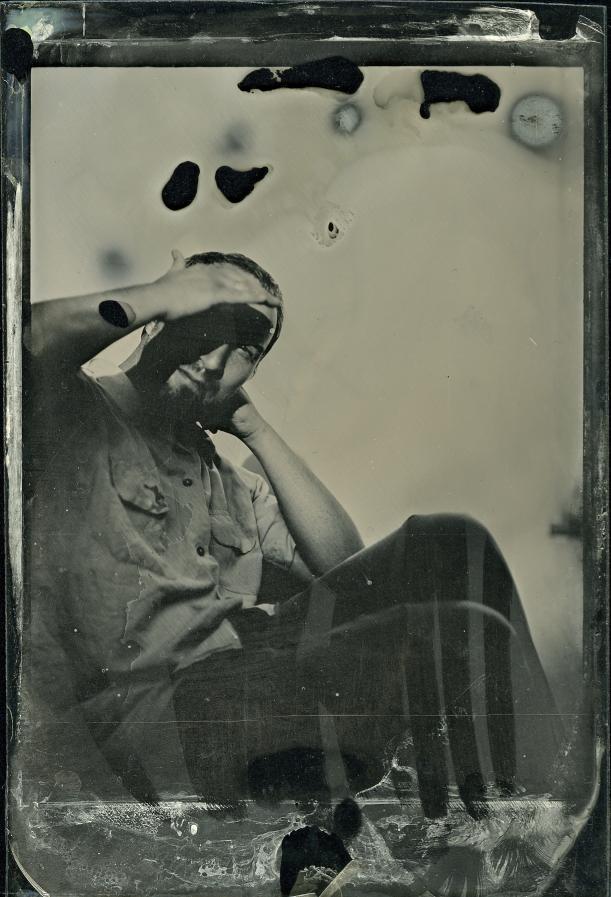
David se za 5sec nehnul.
#148

Publikováno 18 May 2009 - 20:08:18
#149

Publikováno 18 May 2009 - 20:09:42
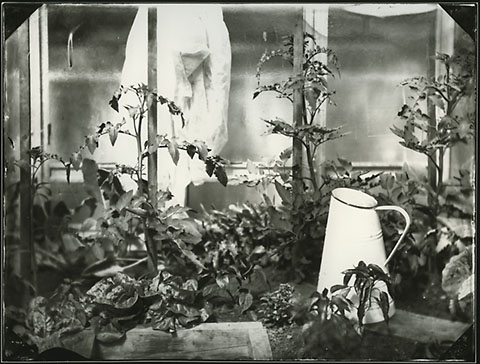
#150

Publikováno 18 May 2009 - 20:12:49
1 uživatel(ů) prochází toto téma
0 členů, 1 návětěvníků, 0 anonymních


















